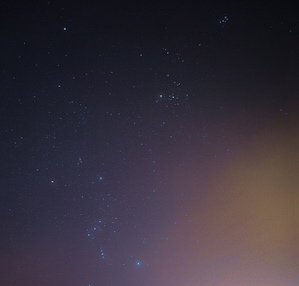
The Pleiades star cluster – also known as the Seven Sisters or M45 – is visible from virtually every place that humanity inhabits Earth’s globe. It can be seen from as far north as the north pole, and farther south than the southernmost tip of South America. It looks like a tiny misty dipper of stars. Follow the links below to learn more about the Pleiades.

The Pleiades, Hyades and Orion.
Pleiades as calendar, in history and in modern science.
How to see the Pleiades. If you’re familiar with the famous constellation Orion, it can help you be sure you’ve found the Pleiades. The image at right shows Orion at the bottom left. See the three stars in a row? That’s Orion’s Belt. Draw a line through the three stars of Orion’s Belt to the right – and you come to a V-shaped pattern of stars with a bright star in its midst. The V-shaped pattern is the Face of Taurus the Bull. The bright star in the V – called Aldebaran – depicts the Bull’s Eye. A bit past Aldebaran, you’ll see the Pleiades cluster, which marks the Bull’s Shoulder. In our image, the Pleiades cluster is at the top right.
Aldebaran, Arabic for follower, is thought to be in reference to this star forever chasing the Pleiades across the heavens. As a general rule, the Pleiades cluster rises into the eastern sky before Aldebaran rises, and sets in the west before Aldebaran sets. The only exception to this rule happens at far southern latitudes – like at South America’s Tierra del Fuego – where the Pleiades rise a short while after Aldebaran rises.
In our Northern Hemispheres skies, the Pleiades cluster is associated with the winter season. It’s easy to imagine this misty patch of icy-blue suns as hoarfrost clinging to the dome of night. Frosty November is often called the month of the Pleiades, because it’s at this time that the Pleiades shine from dusk until dawn. But you can see the Pleiades cluster in the evening sky well into April.

Pleiades star cluster, aka the Seven Sisters. Image Credit: Wikimedia Commons
Legend of the Lost Pleiad. Most people see 6, not 7, Pleiades stars in a dark country sky.

The Lost Pleiad, a painting by French artist William-Adolphe Bouguereau (1825-1905). Image via Wikimedia Commons.
However, the story about the lost 7th Pleiad harbors a universal theme. The astronomer Robert Burnham Jr. finds the lost Pleaid myth prevalent in the star lore of European, African, Asian, Indonesian, Native American and Aboriginal Australian populations.
Moreover, Burnham suggests the “lost Pleiad” may have basis in fact. After all, modern astronomy has found that the 7th brightest Pleiades star – Pleione – is a complicated and hard-to-understand “shell star” that goes through numerous permutations. These changes cause this star to vary in brightness.
Plus people with exceptional eyesight have been known to see many more stars in the Pleiades cluster. Claims go up as high as 20 stars. Miss Agnes Clerke reports that Maestlin, the tutor of Kepler, mapped out 11 Pleiades stars before the invention of the telescope.
However, you must be willing to spend time under a dark, moonless sky to see more than 6 or 7 Pleaides stars. Stephen O’Meara, a dark-sky connoisseur, claims that eyes dark-adapted for 30 minutes are 6 times more sensitive to light than eyes dark-adapted for 15 minutes. The surest way to see additional Pleiades stars is to look at this cluster through binoculars or low power in a telescope.
Pleiades as calendar, in history and in modern science. Historically, the Pleiades have served as a calendar for many civilizations. The Greek name “Pleiades” probably means “to sail.” In the ancient Mediterranean world, the day that the Pleaides cluster first appeared in the morning sky before sunrise announced the opening of the navigation season.
The modern-day festival of Halloween originates from an old Druid rite that coincided with the midnight culmination of the Pleiades cluster. It was believed that the veil dividing the living from the dead is at its thinnest when the Pleaides culminates – reaches its highest point in the sky – at midnight.
On a lighter note, the Zuni of New Mexico call the Pleiades the “Seed Stars,” because this cluster’s disappearance in the evening sky every spring signals the seed-planting season.
In both myth and science, the Pleiades are considered to be sibling stars. Modern astronomers say the Pleiades stars were born from the same cloud of gas and dust some 100 million years ago. This gravitationally bound cluster of several hundred stars looms some 430 light-years distant, and these sibling stars drift through space together at about 25 miles per second. Many of these Pleiades stars shine hundreds of times more brightly than our sun.
Bottom line: Frosty November is often called the month of the Pleiades – or Seven Sisters – because it’s at this time that the Pleiades shine from dusk until dawn. This post tells you how to find the Pleiades, explains the legends of the lost Pleiad, and gives the history and science of this famous cluster.
















